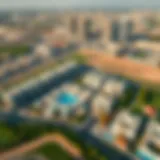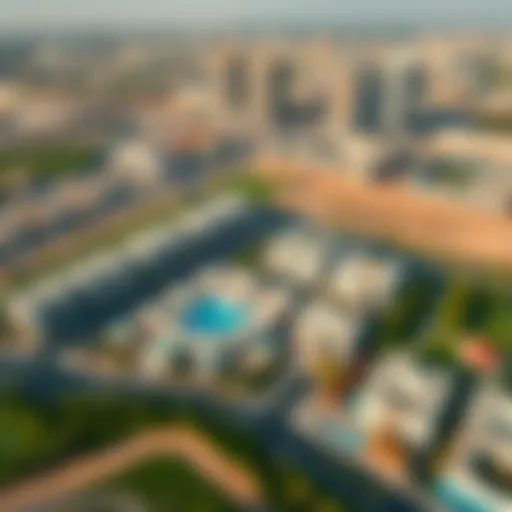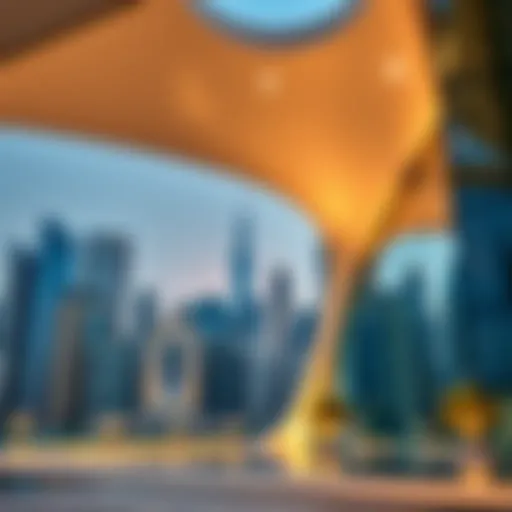Exploring the Vision Behind Mall of the World in Dubai
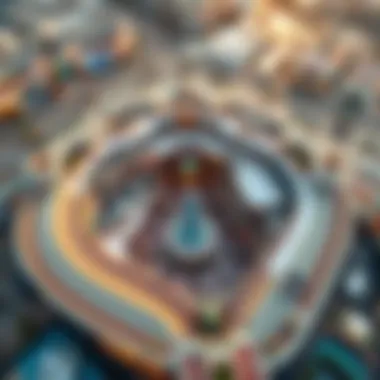
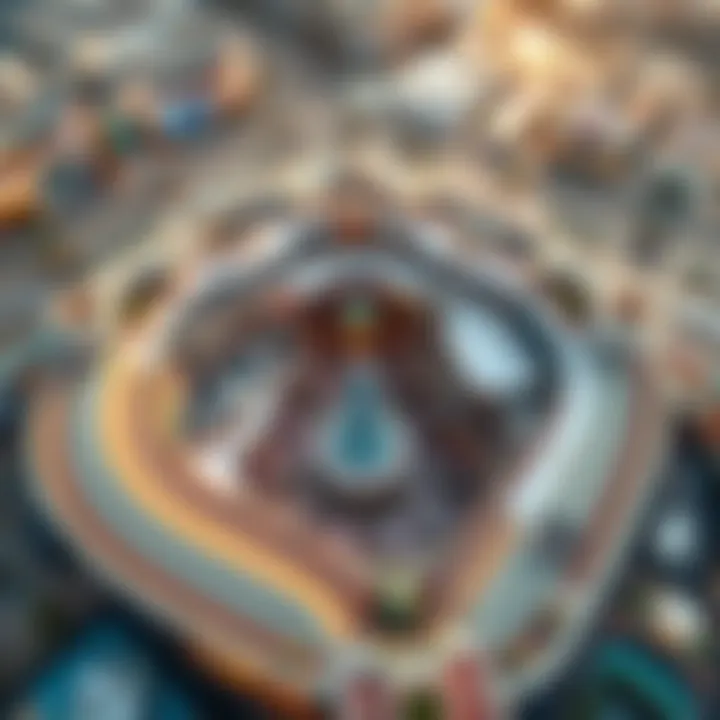
Intro
The Mall of the World is not just an ambitious retail project; it represents a paradigm shift in how we perceive the integration of luxury and culture. Situated in the flashy and vibrant city of Dubai, this concept seeks to create a one-stop destination that encapsulates shopping, leisure, and community interaction. As we delve into the layers that make up this intriguing project, we will explore its architectural brilliance, economic foresights, and societal implications. What does this mean for investors? Is it a mere commercial venture, or could it ultimately reshape the living experience in urban settings?
In this article, we will navigate through the potential impacts of the Mall of the World on Dubai’s real estate market, with special emphasis on market trends, architectural significance, and, of course, the allure it holds for potential investors and homeowners. Preparing for a comprehensive exploration, we signal these subtopics where we scratch the surface of crucial discussions that will follow:
- Current Market Analysis
- Historical Trends and Future Predictions
- Luxury Properties Overview
- Affordable Housing Options
The aim here is clear: to offer a nuanced and thorough understanding of what this groundbreaking mall could symbolize as Dubai continues to carve its path on the global stage.
Prolusion to the Mall of the World
Understanding the significance of the Mall of the World sets the stage for exploring its multifaceted offerings and implications. More than just a retail space, this innovative concept signifies a disruptive shift in Dubai's urban landscape, intertwining luxury with cultural experience. The vision advocates for a self-sustaining ecosystem where shopping meets leisure, promoting social interaction amid a vibrant atmosphere. Additionally, with its scale and ambition, the Mall of the World promises to redefine the benchmarks of consumer experience not only in Dubai but potentially across the globe.
Defining the Vision
The Mall of the World represents a bold synthesis of multiple components. At its core, the vision aims to create an all-encompassing environment that caters to a diverse array of visitors. Imagine wandering through a place where shopping, dining, and entertainment coalesce seamlessly, ensuring that all needs are met under one roof. This far-reaching concept isn’t merely about commerce; it emphasizes a community-centric approach, fostering social bonds while delivering luxury and accessibility.
With its extensive retail footprint and lavish amenities, the project aims to cater to families, tourists, and business professionals alike. It captures the spirit of Dubai as a leader in retail innovation while setting a precedent for future developments. This vision goes beyond conventional boundaries by pushing the envelope on what spaces can achieve and how they can affect the lives within them.
Historical Context
The roots of the Mall of the World can be traced back to Dubai's meteoric rise as a major global city, a transformation that started in the late 20th century. Initially, the region was primarily known for its oil reserves. However, with the diversification initiatives initiated by the government, the focus shifted towards tourism and real estate. This was a game-changer. As international tourism surged, so did the demand for upscale shopping and entertainment options.
Historically, iconic attractions like the Burj Khalifa and the Dubai Mall forged the way for this type of expansive retail environment. The Mall of the World, envisioned as a response to this trend, symbolizes a natural evolution in Dubai's journey. It takes cues from world cities known for their grand infrastructural developments, yet uniquely infuses traditional Middle Eastern cultural elements.
Importance for Dubai's Development
The Mall of the World plays a pivotal role in shaping Dubai's future. It's not just another shopping center; it’s a key component of the strategy to position the emirate as a pre-eminent business and tourism hub. By attracting global tourists and investors, it stimulates economic activities that ripple through various sectors.
Importantly, this comprehensive outlet creates numerous job opportunities, enhancing local employment rates and fostering skill development. It serves as a cornerstone for further real estate developments, thereby positively influencing property values in surrounding neighborhoods. Furthermore, as the mall aspires to be a leader in sustainable practices, it aligns with the UAE's goals for long-term socio-economic stability and environmental responsibility.
This ambitious complex aims to reinforce Dubai's position as a leading global city, while simultaneously enriching and diversifying its economic output.
In a nutshell, the Mall of the World is poised to make a lasting impact on Dubai’s development narrative, intertwining luxury, community, and sustainability to offer a unique living and shopping experience.
Architectural Marvel
The concept of architectural marvel holds significant sway over the Mall of the World. This vast expanse of luxury and community thrusts Dubai into the limelight, urging both residents and tourists to explore its heights—literally and metaphorically. It is more than just an amalgamation of stores and attractions; it represents an innovative one-step further in architectural design, addressing aesthetic, functional, and environmental concerns all in one breath.
Design Philosophy
At the heart of the Mall of the World lies a distinctive design philosophy that marries traditional artistry with cutting-edge innovation. Inspired by the cultural tapestry of Dubai, the structure flows seamlessly with its surroundings, encouraging a dialogue between its form and the environment. This design does not merely stand out; it embodies the spirit of a vibrant city that is constantly evolving.
Features of this philosophy include:
- Use of local materials galvanized into modern construction, reducing the carbon footprint.
- A layout that prioritizes natural light and ventilation, creating a welcoming atmosphere.
- Spaces that encourage social interaction while providing areas for privacy.
The overall effect is a tactile experience that is both striking and familiar, catering to a diverse audience who seeks novelty while finding comfort in cultural references.
Sustainable Building Practices
Sustainability serves as a cornerstone of the architectural approach taken at the Mall of the World. Here, building practices are not just a trend; they are woven into the ethos of the project. Every brick laid and every panel installed reflects a commitment to environmental stewardship.


Key sustainable practices observed include:
- Water conservation techniques: Incorporation of systems that capture and recycle water, especially given the arid climate.
- Energy-efficient systems: Utilizing solar panels and state-of-the-art HVAC (Heating, Ventilation, and Air Conditioning) units to minimize energy consumption.
- Green spaces: Internal gardens and playful courtyards that not only beautify but also assist in temperature regulation.
This eco-friendly design is critical for investors and homebuyers who increasingly prioritize sustainability in their purchasing decisions, enabling a healthier future for the region.
Integration of Public Spaces
A key feature of the Mall of the World is its cherished integration of public spaces. These areas are crafted with the intention of fostering community interaction, making the mall not just a shopping destination but a true social hub.
Notable aspects include:
- Open plazas: Large common areas designed to host events, markets, or art showcases, inviting residents and tourists to mingle.
- Art installations: These blend seamlessly into the architecture, allowing local artists to display their work while enriching the aesthetic experience.
- Accessibility: Thoughtful navigation pathways ensure that everyone can enjoy the spaces, reflecting an understanding of diverse visitor needs.
As more developments emerge in Dubai, having a central venue where public engagement is prioritized can enrich community ties, providing a blueprint for future urban projects.
"The integration of public spaces transcends mere function; it cultivates a sense of belonging, proving that architecture is far more than just buildings."
Cultural and Retail Environment
The cultural and retail environment of the Mall of the World plays a crucial role in shaping not only the shopping experience but also the social fabric of Dubai. This sprawling complex is positioned to be more than just a shopping destination; it's designed to be a cultural hub that fosters connections, showcases local artistry, and celebrates a diverse array of global influences. Understanding this dimension is vital for investors, homebuyers, and developers eager to tap into the unique offerings of this monumental project.
Diverse Shopping Experience
The retail landscape at the Mall of the World is poised to cater to an extensive range of consumer preferences, blending luxury brands with more affordable options. One can expect to find everything from high-end boutiques featuring the latest couture to quaint shops selling local craft items. The diverse shopping experience means that whether you’re a penny-pincher or someone who enjoys splurging, there is something for everyone.
Additionally, this variety extends beyond just products; it encompasses retail formats too, including pop-up shops, experiential marketplaces, and concept stores. These innovative setups not only enhance shopping but also create engaging interactions that resonate with a broad audience.
Culinary Offerings
Dining in the Mall of the World transcends mere sustenance; it emerges as a flavorful journey through various cuisines. Visitors will have the opportunity to savor fine dining experiences alongside casual eateries, food markets, and even food trucks parked strategically throughout the complex. Local favorites and international delicacies will intermingle to create a culinary tapestry that attracts food enthusiasts as well as casual diners.
Importantly, special attention will be given to include cuisines that reflect Dubai's multicultural identity, allowing visitors to experience flavors that span continents. Whether you're in the mood for street food that brings back memories of bustling markets or a gourmet meal that elevates dining to an art, the Mall's diverse culinary offerings promise something that will tickle the taste buds.
Art and Entertainment Integration
Art and entertainment are not mere accessories in this environment; they serve as integral components that enhance the overall experience of the Mall of the World. Imagine this: visitors strolling through art installations that might mirror the effervescent spirit of Middle Eastern culture or live performances that draw influences from around the globe.
The integration of art is intended to provoke thought and inspire creativity, making each corner of the mall a chance to explore artistic expressions whether through visual art or performing arts.
Furthermore, the entertainment options will range from cinemas showcasing international films to live concerts featuring both local artists and globally renowned musicians. Such activities can not only draw foot traffic but also enhance the social aspect of retail, bringing people from all walks of life together in shared experiences.
"In a world where shopping can often feel transactional, the Mall of the World aims to redefine it by crafting an experience where culture, community, and commerce seamlessly intertwine."
Economic Impact
The economic implications of the Mall of the World go far beyond its immediate surroundings. It is not just a matter of retail space; it signals a grand ambition for Dubai, aiming to transform its economy into one that thrives on tourism, innovation, and retail. The interplay between various economic elements within this establishment will pave the way for potential benefits, considerations, and a sustainable framework for growth.
Job Creation and Opportunities
A significant feature that stands out in the economic impact of the Mall of the World is its potential for job creation. Thousands of jobs are expected to emerge as construction progresses, and this trend will continue with the mall's operational phase. The jobs won’t just be in retail, but also in hospitality, management, maintenance, and security. More specifically:
- Job variety: Positions will range from senior management roles to entry-level customer service jobs, catering to a wide array of skills and experience.
- Training Programs: Local businesses and educational institutions might collaborate to create training programs to equip potential employees with relevant skills.
- Long-term careers: Many positions may offer career progression opportunities in both retail and hospitality sectors, fostering a workforce ready for the future.
By offering these employment opportunities, the Mall of the World can contribute to reducing unemployment in the region, buoying the local economy in a direct manner.
Influence on Real Estate Values
The establishment of a large-scale project like the Mall of the World inherently influences the surrounding real estate market. It's a domino effect: as the mall attracts more visitors, nearby properties become increasingly desirable, leading to a surge in real estate values. Here are key points to consider:
- Rising Demand: Properties close to the mall could see a rise in demand, as both investors and homebuyers might want a stake in this attractive location.
- New Developments: With the anticipation of higher traffic in the area, developers may seek to invest in residential and commercial projects, driving even more growth.
- Property Appreciation: Long-term, investors might see significant property appreciation, making it a beneficial move for those who act early in acquiring properties nearby.
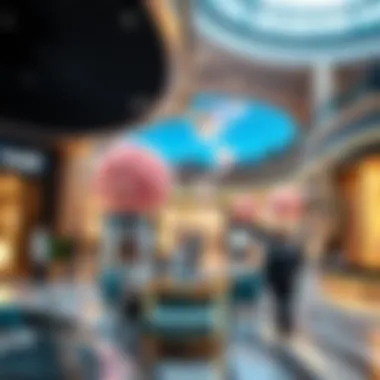
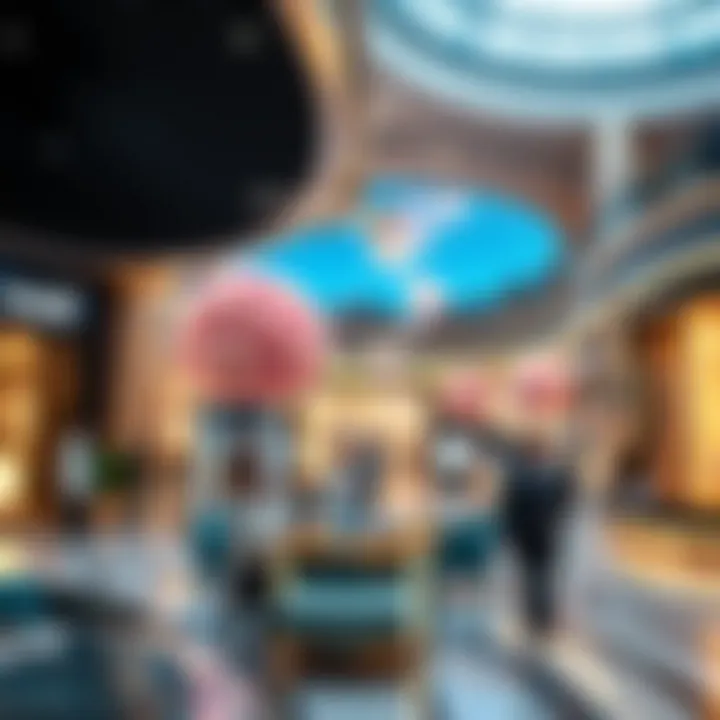
As these changes take root, the overall property ecosystem in Dubai may shift, accommodating new residents and businesses eager for a connection to this grand retail hub.
Attracting Global Investment
In the world of finance, attracting global investment is akin to hitting the jackpot, and the Mall of the World is positioned to do just that. Dubai has long been known for attracting attention from investors, but this development elevates its appeal. Consider the following factors:
- Global Phenomenon: As one of the largest malls in the world, it could attract brands and retailers on a global stage, providing a platform that no other development has ventured into.
- Tourism Boost: The influx of visitors will not only support retail growth but also encourage investment across various sectors like hospitality and entertainment, further enhancing Dubai’s attractiveness.
- Diversified Portfolio Options: Investors looking for diversified opportunities can find various sectors represented at the mall, from luxury goods to budget-friendly offerings, making it a versatile investment prospect.
As the world becomes increasingly interconnected, the Mall of the World stands as a symbol of Dubai's capacity to attract global interests while fostering local opportunities.
Investment in the Mall of the World is not merely placing bets on a retail space; it is about investing in a future that redefines luxury, culture, and commerce simultaneously.
The multifaceted economic landscape carved out by the Mall of the World marks it as a crucial element in Dubai’s ongoing journey to build not just a city, but a thriving economic ecosystem.
Challenges and Considerations
Economic Sustainability
Navigating the financial landscape of the Mall of the World concept requires an understanding of its economic sustainability. It is vital for this ambitious project to establish a solid foundation that transcends short-term gains and fortifies long-term viability. Investors need to scrutinize the recurring costs of maintaining such a large-scale facility against potential revenue streams. For instance, the integration of mixed-use properties within the mall could stimulate diverse income sources, ensuring cash flow remains healthy. Moreover, this approach can assist in mitigating risks that arise from fluctuations in retail performance, particularly in a market influenced by global trends and consumer behavior shifts.
When considering economic sustainability, one must not overlook the potential for job creation. The Mall of the World can act as a catalyst for employment opportunities, thus driving local economies. However, untreated economic pressures, such as over-saturation of retail space, can lead to a crisis of adaptability, where consumers pull back their spending. Therefore, stakeholders must continuously innovate and evaluate market dynamics to uphold the mall’s economic health.
Environmental Concerns
With the growing emphasis on climate change and sustainability, the environmental ramifications of the Mall of the World cannot be brushed aside. As it takes shape in the heart of Dubai, the design and planning phases are crucial. How does one balance luxury with ecological responsibility? Utilizing energy-efficient building practices and renewable energy sources could rightfully address some of the concerns surrounding large retail complexes.
Building material choices also bear significant weight in reducing the environmental footprint. For example, sourcing local materials not only supports the community but also cuts down on transportation emissions. Furthermore, integrating green spaces, such as parks and gardens, into the mall’s design can enhance air quality and provide residents and visitors with traditional community touchpoints.
In essence, it is not just about how the mall functions today; it is about ensuring its ecological impact is sustainable for future generations. Investors and developers alike are tasked with finding that critical balance between profit and planet.
Cultural Adaptation
Cultural considerations are indispensable in ensuring the success of the Mall of the World. Dubai is an intricately woven tapestry of various cultures, each bringing unique influences and expectations. To appeal to both locals and international visitors, the mall must serve as a microcosm of this diverse cultural landscape.
The architectural style, for instance, should reflect both modernity and tradition. A blend of contemporary designs with local elements can create a sense of belonging for residents while also dazzling tourists. Additionally, understanding the customs and preferences of different cultural groups can inform the retail offerings and services available within the mall. Not all appetites are the same, and offering a medley of dining options, retail brands, and leisure activities can cater to a broader audience.
Incorporating local art and hosting cultural events can bridge gaps and foster community engagement. This not only elevates the mall as a shopping destination but transforms it into a cultural hub—an essential element for any ambitious development project. In doing so, the Mall of the World can become more than just a place to shop; it can establish itself as a key player in the vibrant cultural narrative of Dubai, enhancing both its market appeal and its social footprint.
Implications for Homebuyers and Investors
Investing in the Mall of the World presents a multitude of implications for homebuyers and investors alike. The enchanting allure of this innovative retail and leisure complex is not purely aesthetic; it signifies profound shifts in the real estate landscape of Dubai. With the promise of luxury blended with cultural experiences, understanding the potential ramifications for various stakeholders is crucial.
Investment Potential
Buying property in close proximity to the Mall of the World could yield significant returns. With a projected influx of visitors and residents, prices may rise as demand for quality housing follows. Homes near key attractions often sell at a premium. Proximity to high-profile developments like the Mall of the World entails not just higher property values but also increased rental yields. Given the scale of the project, real estate investors might witness an escalation in both short-term and long-term profits.
Furthermore, the diversity in retail and entertainment options can make investing in the area more attractive. The retail space within the Mall is expected to be a magnet for various luxury brands, potentially drawing in the affluent demographic both locally and abroad. This brand presence serves to elevate the neighborhood, further enhancing property values.
"Real estate is not just about location; it’s about surrounding opportunity."
Lifestyle Considerations
The lifestyle implications of residing near the Mall of the World cannot be overstated. For homeowners, the combination of upscale living with access to unparalleled amenities is unmatched. Walking paths, green spaces, and communal areas can foster a vibrant community life.
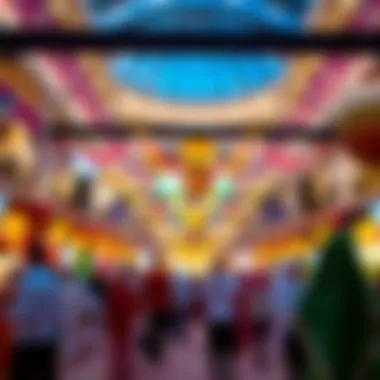
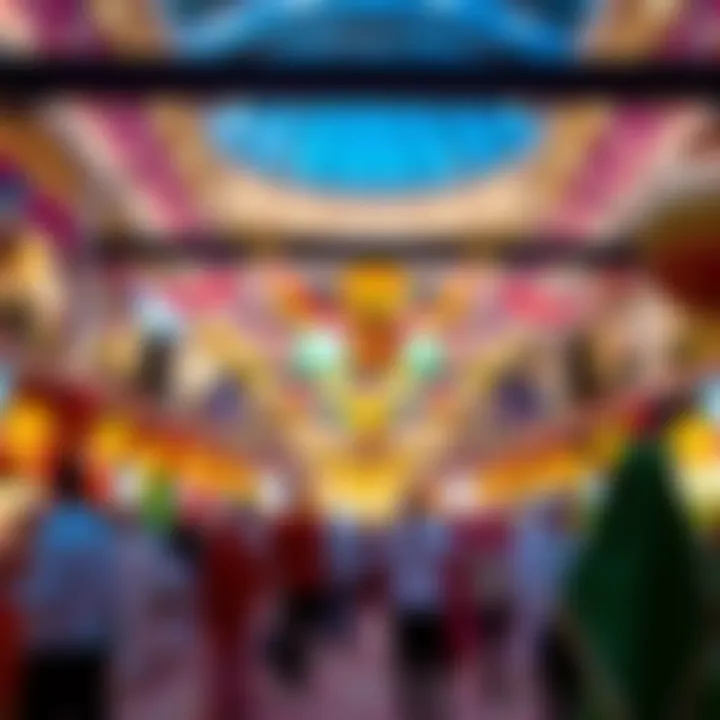
Residents can expect to enjoy an array of choices at their doorstep, from gourmet dining to entertainment options that cater to every age group. The cultural integration within the Mall fosters a unique community atmosphere, combining global cultures with local traditions. Families, professionals, and expatriates will find the comforts of modern living seamlessly woven into a fabric of cultural richness.
Considering long-term lifestyle, it’s imperative to recognize how such developments can enhance everyday life. The accessibility of various services—from shopping to education—could contribute significantly to a higher quality of life for residents.
Market Trends Insights
Keeping an eye on market trends is essential for savvy investors. The emergence of giant retail complexes like the Mall of the World generally signals shifting paradigms within the real estate sector. Observing how similar projects have influenced market movements elsewhere can provide insights.
Past patterns offer valuable lessons; for instance, analyzing trends from other massive developments worldwide can inform expectations. The Mall of the World may set benchmarks for luxury and convenience, thus altering demand dynamics for housing. Buyers should also monitor the development of supporting infrastructure—schools, public transit options, and healthcare facilities—as these will play a critical role in determining property value.
As the project continues to unfold, investors who pay attention to these improvements will be poised to capitalize on emerging opportunities, allowing them to make informed decisions about future investments.
Future Prospects
The concept of the Mall of the World is not just about a shopping complex; it encompasses a vision that extends far beyond retail. The future prospects of such an ambitious project offer significant implications for Dubai’s evolving identity as a global hub. Here, we will delve into the expected developments, the long-term vision for Dubai, and the innovative retail concepts that could emerge from this project.
Expected Developments
As Dubai positions itself for various global events and heavy tourism influx, the Mall of the World aims to become a pillar in this evolving landscape. Expect developments such as:
- An increase in mixed-use spaces combining residential, commercial, and leisure facilities.
- Platforms for cultural exchanges, perhaps featuring rotating art exhibitions that celebrate local and international artists.
- Enhanced public transport connectivity, making access easier for both residents and tourists.
- Incorporation of tech-infused retail experiences, such as virtual reality shopping and interactive installations.
Future expansions could also focus on creating a sustainability index—aiming for zero energy consumption through innovative building materials and renewable energy sources. In essence, what is on the horizon is a reimagining of how a retail space can integrate life, culture, and commerce in one cohesive unit.
Long-Term Vision for Dubai
The vision for Dubai stretches far beyond the immediate benefits. The Mall of the World aligns closely with the emirate’s aspirations to become a premier global city. What this translates into:
- Economic Diversification: By promoting unique attractions, Dubai can reduce its dependence on oil revenues, opening doors to new industries, especially in tourism and retail.
- Cultural Integration: The Mall serves as a microcosm of cultural diversity, aiming to attract a spectrum of nationalities—all contributing to a rich, multicultural environment. This also plays into Dubai's goal of being a beacon of cultural understanding.
- Urban Development: With this mall at the core, surrounding areas will likely experience rapid development. Increased foot traffic can lead to new businesses, impacting adjacent real estate positively.
The synergy created by this mega project could redefine Dubai's skyline while enhancing global perceptions of the city.
Innovative Retail Concepts
While traditional retail will certainly find a home in the Mall of the World, innovative concepts are anticipated to breathe life into the shopping experience:
- Experiential Shopping: Instead of merely purchasing items, patrons may engage in experiences, such as workshops featuring local craftsmanship or pop-up markets highlighting unique goods.
- Technology Integration: From artificial intelligence-driven customer service to omnichannel shopping experiences that blend online and offline spaces, innovation will be at the heart of retail.
- Sustainability Focus: Brands within the mall might emphasize eco-friendly products, packaging, and practices. Shoppers increasingly demand sustainable options, and retailers will need to adapt accordingly.
In summation, the future prospects of the Mall of the World reflect a significant paradigm shift in how retail spaces can serve communities, blending culture and commerce while enhancing Dubai's global stature. Investors, realtors, homebuyers, and developers must keep an eye on these developments as they unfold, for the implications are as fascinating as they are numerous.
For further readings, you might find these resources insightful:
Closure
As we draw the curtains on our exploration of the Mall of the World, it’s important to highlight the multifaceted significance of this groundbreaking initiative within Dubai's evolving landscape. The implications of such a bold concept extend far beyond mere leisure and shopping; they encapsulate the spirit of a city poised at the crossroads of tradition and innovation.
Retrospective of Impact
Looking back at the journey of the Mall of the World concept, one can see how it mirrors Dubai’s ambitious ambitions. This undertaking not only offers up an extravagant shopping experience but also represents a shift in how urban spaces can function harmoniously. Its architecture tells a story—one of fusing opulence with sustainability. Infrastructure development leads to job creation, stimulating economic growth, which invariably enhances the standard of living for residents. Furthermore, the architectural significance alone is worthy of admiration. The fusion of local culture and global influences sets it apart as a landmark.
The Mall of the World could very well redefine the retail and leisure industries in the region, elevating Dubai's status as a global hub.
With regards to real estate dynamics, this development holds the potential to raise property values and attract global investment, creating a ripple effect throughout Dubai's economy. From investors' perspectives, the Mall presents a unique opportunity that aligns with emerging market trends focused on luxury and lifestyle.
Final Thoughts
In concluding, one's consideration of the Mall of the World should not simply rest on its extravagant offerings but rather on its broader implications. It symbolizes an ambitious vision—one that encapsulates economic resilience and cultural richness amid a transformative phase of urban development. As investors, realtors, and developers consider their stakes in this venture, it's crucial to grasp the long-term benefits: enhanced lifestyle opportunities, augmented property values, and enriched community experiences. The Mall of the World is not just a shopping complex; it's a cornerstone of a pioneering future that could shape the real estate landscape for years to come.
In this vibrant environment of ongoing infrastructural evolution, keeping an eye on ground realities and adapting strategies accordingly will be key for those looking to make the most of what Dubai’s ambitious future has to offer.
